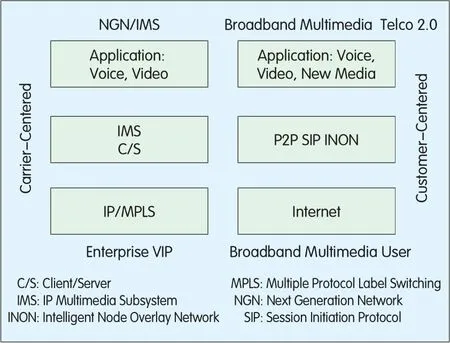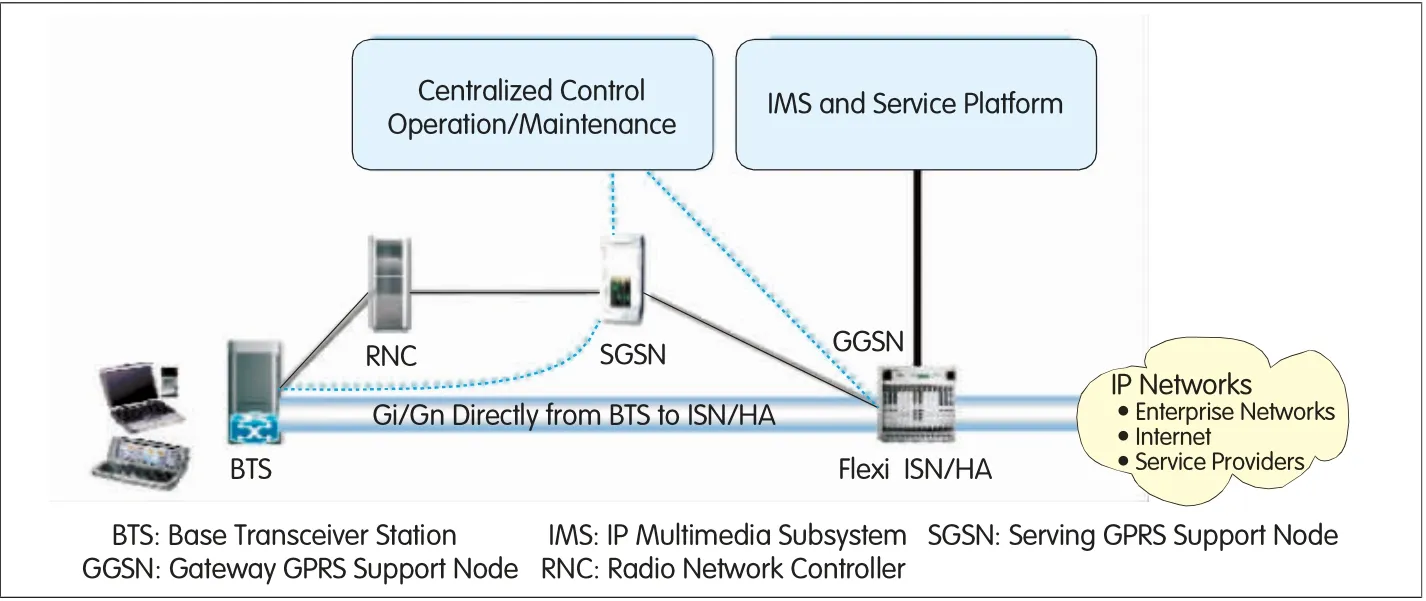Mobile Internet Oriented 3G Teleco 2.0
Hou Ziqiang
(Institute of Acoustics, Chinese Academy of Science, Beijing 100080, P. R. China)
Abstract:Mobile Internet will be the killer application of 3G.For the mobile Internet,the business model of telecom operators has to evolve to Teleco2.0.IP Multimedia Subsystem(IMS)will be used mainly for VIP and enterprise customers.Mass-oriented entertainment and new media services will be based on the Intelligent Node Overlay Node(INON)/Distributed Service Network(DSN).The core network will be flat,with an evolution route from Internet High Speed Packet Access(I-HSPA)to System Architecture Evolution(SAE),and even the Internet can be used as the core network.The low-cost mobile phone can be accessed to HTTP Internet by using“client end software+portal”model with cloud computing.Flat rate will be the only fee model to be accepted by customers,and cheap and reasonable prices will contribute to the development of mobile Internet.
I t is a subversive reform from Teleco I.0 to Teleco 2.0.The operation philosophy,operation mode,charging mode,and network architecture will change.Most carriers are not ready for the reform.For carriers,impacted by internet,the only bright way is turning to the mobile Internet[I]and to transit to Teleco 2.0.
1 From IMS to INON/DSN
Currently,the 2G/3G network of mobile carriers uses the IP/MPLS-based manageable IPcore network.On the IP core network,the IMSplatform is constructed to provide various applications.The structure constructs a"Walled Garden"for carriers and provides network basis for dominant industrial chain.It inherits the TelecoI.0 mode,but cannot meet the requirements of mobile internet-oriented Teleco 2.0.
The enclosed structure of the IMS centralized control provides service for VIPenterprise customers who require QoSand security.It is not suitable for open mobile internet.The features of open,autonomy,and omnipresence of Internet provide broad space for mass entertainment and new media.It is a real customer-centered mode.
The value proposition of the network is determined by the operation mode,namely,the generation of digital content,distribution,and delivery method.For traditional broadcast network,according to the Sarnoff law,the network value is proportional to the number of audience.For Internet,the interactive network,according to the Metcalfe law,the network value is proportional to the square connected nodes.The development of Internet community service increases the dimension of creating values.According to the reed law,with the increase of community users,the revenue of community group services increases geometrically.The network value is changing in to the state expressed by Reed law from Sarnoff law and Metcalfe law.Only the openness of the network can reflect the maximum value.
In the last few years,P2P-based VoIPtelephone,content download,and stream media are developing rapidly.P2Phas become the major mode of providing audio and video services in the internet.The P2Pservice is running on the public Internet in the mode of overlay network.IMSuses client/server architecture and thus does not support the P2Pservice.To manage the P2P service,Intelligent Node Overlay Network(INON)is developed.Paralleling with IMS,the INON distributed management platform should created in the public Internet to provide supporting environment[2],as shown in Figure I.
The INONnetwork is a new overlay network technology integrating Resilient Overlay Network(RON)technology,which covers the IPcore network,and Distributed Hash Table(DHT).It includes automatic networking,network resource management,and route optimization technologies.The basic structure is that:TCP/IPprotocol remains unchanged;the originallayer 3 becomes layer 3-,on which,an INON serves as layer 3+.On the distributed management platform,services including traffic monitoring,traffic control,QoS,Antivirus,and security are provided.
Another task of an INON is to provide supporting environment for various P2P applications.It provides universal supporting environment for various P2P services adopting different protocols and software.It mainly provides P2PCDN and P2PSIP.The INON network is shown in Figure 2.

▲Figure 1. Creating a distributed management system in the overlay network mode.
China Mobile Company observed the demands of Teleco 2.0 and the limitations of IMS.It started to launch the research for Wireless Internet/IPService Environment(WIISE)and released Distributed Service Network(DSN)Whitepaper[3].Paralleling with the IMSon manageable IPnetwork,China Mobile started the research for creating DSN(equivalent to preceding INON)on the public mobile internet.The key of developing DSN is to provide distributed management and supporting environment to face the demands of future mobile Internet and new network media.This conforms to the development trend and seizes the opportunities.
The DSN concept is evolving.Remaining the openness of the Internet is very importan.DNSshould support various applications in the Internet.The focus is to encourage and support inexhaustible applications in the Internet,rather than to develop new application.By doing this,a healthy industry chain can be formed.In the construction of 3G network,some carriers think that the IMS is insufficient.Actually,it is wrong despite of the extra investment.
2 Flat Core Network
The network architecture of 3G network including TD-SCDMAand WCDMA deployed in China follows the 3GPPR99 structure,namely,the uplink/downlink data of base stations is connected to the service platform through Radio Network Controller(RNC)and Serving GPRS Support Node(SGSN).The network structure requires that each NEshould unpack-encapsulate-forward packets[4].When the empty interface has the High Speed Packet Access(HSPA)capability,the HSPA data converged from thousands of communities requires higher processing capability from each NE,especially RNC.
Take the maximum rate I4.4 Mbit/s of HSDPAas an example,a HSDPA network of I,500 sectors generates the data bulk of 2I.6 Gbit/s.Currently,the data throughput of RNC is only I Gbit/s.The 3G network and the 2G network of carriers share a core network,whose bandwidth and data processing capability cannot meet the requirements of HSPA high data rate.When the data load increases dramatically,the carriers have to face the huge pressure of expanding RNC/SGSN.In addition,unpacking packets at each node causes extra delay for each node.As a result,longer network delay is generated.
For the mobile Internet applications,the hierarchicalnetwork structure is not necessary.Flat network can simplify the devices and reduce the cost,at the same time,shorten the delay.I-HSPAemerges as required.Through the architecture,the base stations are connected to the GGSN(gateway to the Internet and data service)node via Gi/Gn interface[5].The principle of I-HSPAis illustrated in Figure 3.
The direct link can create channels for user data flow to bypass RNC and SGSN of traditional architecture,which saves the transmission cost.It can also save the investment for expanding the RNC/SGSNwhen the data load increases significantly.In addition,for Gi/Gn,the MAN Ethernet provide the Ethernet private line,whose cost is far lower than that of EI/TI.As a result,the cost for creating transmission network is significantly reduced.At the same time,the transmission path is reduced.Consequently,the delay is also shortened.The Return Transmission Time(RTT)can be reduced to less than 25ms.The flat network is further demonstrated in LTE/SAE.
Both I-HSPA and SAEretain a manageable IPcore network.The access network connecting the base station and the Evolved Packet Core(EPC)network connecting the gateway and MME/UPA are the manageable private network of mobile carriers.The core network gateway is connected to the Internet through the SGiinterface of the access gateway.The mobile carriers provide various applications on the IP/MPLS based manageable IPcore network EPC through the IMSplatform.The structure constructs a"Walled Garden"for carriers and provides network basis for dominant industrial chain.It inherits the TelecoI.0 mode,but cannot meet the requirements of mobile internet-oriented Teleco 2.0.
Orienting the mobile internet,the most simple and effective method of the network architecture is that the base station directly accesses the internet.Do not reserve the manageable IPcore network EPC.Put the mobility management function to the internet.The B structure of WiMAXNRM RI is closest to this structure.In B structure,ASN gateway is not used.The function is implemented by the switch and router on the internet.Unfortunately,in order to getting close to the cellmobile communication because of the 3G network,WiMAXuses C structure similar to LTE.ASNgateway and manageable core network(ASN and CSN)are reserved.It uses IMSto provide services.

▲Figure 2. P2P-based INON.
This drops its advantages[6].

▲Figure 3. Packet-optimized I-HSPA solution.
3 Portal Plus Client Software to Cloud Computing
Owing to small screen and weak computing capability,mobile phones can only access limited WAPwebsites and cannot access millions of HTTPwebsites.This limits the applications.Some high-end smart phones including iPhone can access HTTPwebsites.But owing to the small screen size and the sliding window mode,it is not convenient to view HTTPwebsites.The Portal plus Client mode changes the situation,which is significant to the development of mobile internet.The portal websites provide the capability of navigation,protocol,and format conversion.By downloading and installing the client software,the customer can browse WAPwebsites and log in to browse HTTPwebsites,viewing the format suitable for mobile phones.In addition to watching the WAPvideo programs,you can also watch the video contents in the HTTPvideo websites.Various Web2.0 applications are supported.Major problems of mobile phone surfing are solved.UCWEBis the most successful portal website in China.In 2008,the number of installed and activated clients reaches 60 million.
Through this mode,more computing power is transferred from the mobile phone to the network side.With the increase of mobile Internet users and the broadband video services,the requirements for the protocol conversion,format conversion,and content storage capability of the portalwebsite are dramatically increasing.The solution is to adopt cloud computing platform.The cloud computing platform also provides the INON/DSN function mentioned previously to provide supporting environment for the mobile internet.For carriers,it is important to construct the supporting environment.
Some mobile phones do not have the corresponding supported clients or the users do not know how to download and install client software.Therefore,carriers should customize or encourage low-cost high-performance mobile phones,in which,client software should be pre-installed to provide"push-to-surf"service.This can improve the competitiveness and promote the progress of mobile internet.Thereby,promote the development of 3G network.
4 Flat Rate
Even in the mobile Internet era,it is profitable for carriers to provide basic transmission services.Up to 20II,if the number of mobile Internet users of China Mobile reaches I00 million,assume the access fee of each user is 50 yuan,the annual revenue will come to 60 billion yuan.
Practically,the acceptable charging mode is flat rate.The broadband service grows rapidly owing to the flat rate.The charging mode is also suitable for mobile internet.In 2006,Hutchison-whampoa first provided the flat rate for the access service.One year later,the flat rate service spreads over Europe and America:the traffic of mobile Internet increases sharply.Currently,telecom carriers do not care the impact of Skype VoIPservice.Carriers in Europe and America allow flat rate users of data service to use the Skype phone.With the deployment of 3G HSPA,the capacity increases significantly.The decreasing broadband cost makes flat rate possible.If the mobile phone surfing can lower the tariff to RMB 20 yuan per month(for 2GB traffic),or provide a package with voice service,the mobile Internet in China will grow more rapidly.For the surfing of laptop computer,the flat rate of RMB I00 yuan without traffic limit is acceptable for most users.Presently,the price standard stimulated by three major carriers is still too high,which is not attractive enough for users and thus cannot promote the rapid development of mobile Internet.
Mobile Internet is the trend of network development.The one who turns to mobile Internet first can win the competition in the future,as a proverb says:trend-adaptive one flourishes;opportunity-seizer will be the king.
- ZTE Communications的其它文章
- Mobile Internet Application Infrastructure: An Open Garden
- Discussion of Mobile Internet Service Development
- New Blue Ocean of Wideband Wireless Mobile Internet: Modern Service
- Development and Innovation of Mobile Internet
- Standards for Mobile Internet Technologies
- Security Framework of Mobile Internet

